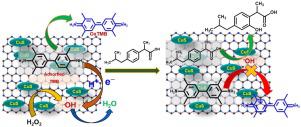Journal of Environmental Chemical Engineering ( IF 7.4 ) Pub Date : 2020-10-17 , DOI: 10.1016/j.jece.2020.104635 Priyakshree Borthakur , Purna K. Boruah , Manash R. Das

|
This work reports a selective and sensitive method for detection of Ibuprofen (Ibu), a nonsteroidal anti-inflammatory drug (NSAID) based on the peroxidase mimic activity of CuS nanoparticles (NPs) decorated on 2D graphitic carbon nitride (g-C3N4) and hexagonal boron nitride nanosheets (h-BN). CuS/g-C3N4 and CuS/h-BN nanocomposites are synthesized by simple hydrothermal technique and characterized by different sophisticated analytical techniques like XRD, BET, HRTEM and XPS analysis. The surface charge of the nanocomposites is determined by zeta potential analysis. The peroxidase mimic activity of the nanocomposites are analyzed by carry out the catalytic oxidation of 3, 3ʹ, 5, 5ʹ-tetramethylbenzidine (TMB) in presence of H2O2 to produce a blue colored oxidized product (oxTMB). The synthesized nanocomposites are employed for the colorimetric detection of Ibu as a model pharmaceutical pollutant in an aqueous medium. Ibu is commonly used by man to cure certain ailments and excreted in environmental wastewaters that have several bad effects. The principle of sensing is the inhibition of the peroxidase mimic activity of the nanozymes by Ibu. The detection limit of Ibu achieved in the colorimetric detection is found to be 16.01 and 21.20 mg/L (ppm) within the linear range of 0-100 mg/L in presence of CuS/g-C3N4 and CuS/h-BN nanocomposites, respectively. The practical application of the proposed sensor is successfully demonstrated using various environmental water samples spiked with different concentrations of Ibu. The proposed sensing probes exhibit high specificity and anti-interfering ability over other water contaminates and considerable feasibility in real water systems.
中文翻译:

在二维纳米片上轻松合成CuS纳米粒子,作为检测水中布洛芬的有效人工纳米酶
这项工作报告了一种选择性和灵敏的方法,用于检测布洛芬(Ibu),这是一种非甾体抗炎药(NSAID),其基于二维石墨化碳氮化物(gC 3 N 4)上装饰的CuS纳米颗粒(NP)的过氧化物酶模拟活性。六方氮化硼纳米片(h-BN)。通过简单的水热技术合成了CuS / gC 3 N 4和CuS / h-BN纳米复合材料,并通过不同的复杂分析技术(如XRD,BET,HRTEM和XPS分析)进行了表征。纳米复合材料的表面电荷通过ζ电势分析确定。通过在H存在下进行3,3ʹ,5,5ʹ-四甲基联苯胺(TMB)的催化氧化来分析纳米复合材料的过氧化物酶模拟活性2 O 2产生蓝色的氧化产物(oxTMB)。合成的纳米复合材料用于比色法检测水性介质中作为模型药物污染物的Ibu。人们通常将伊布(Ibu)用于治疗某些疾病,并将其排泄到环境废水中,这些废水会产生多种不良影响。感测原理是Ibu抑制纳米酶的过氧化物酶模拟活性。在存在CuS / gC 3 N 4的情况下,在0-100 mg / L的线性范围内,在比色检测中达到的Ibu的检出限为16.01和21.20 mg / L(ppm)。和CuS / h-BN纳米复合材料。所提出的传感器的实际应用已成功地通过加标了不同浓度Ibu的各种环境水样品得到了证明。所提出的传感探针具有比其他水污染物高的特异性和抗干扰能力,并且在实际水系统中具有相当大的可行性。









































 京公网安备 11010802027423号
京公网安备 11010802027423号